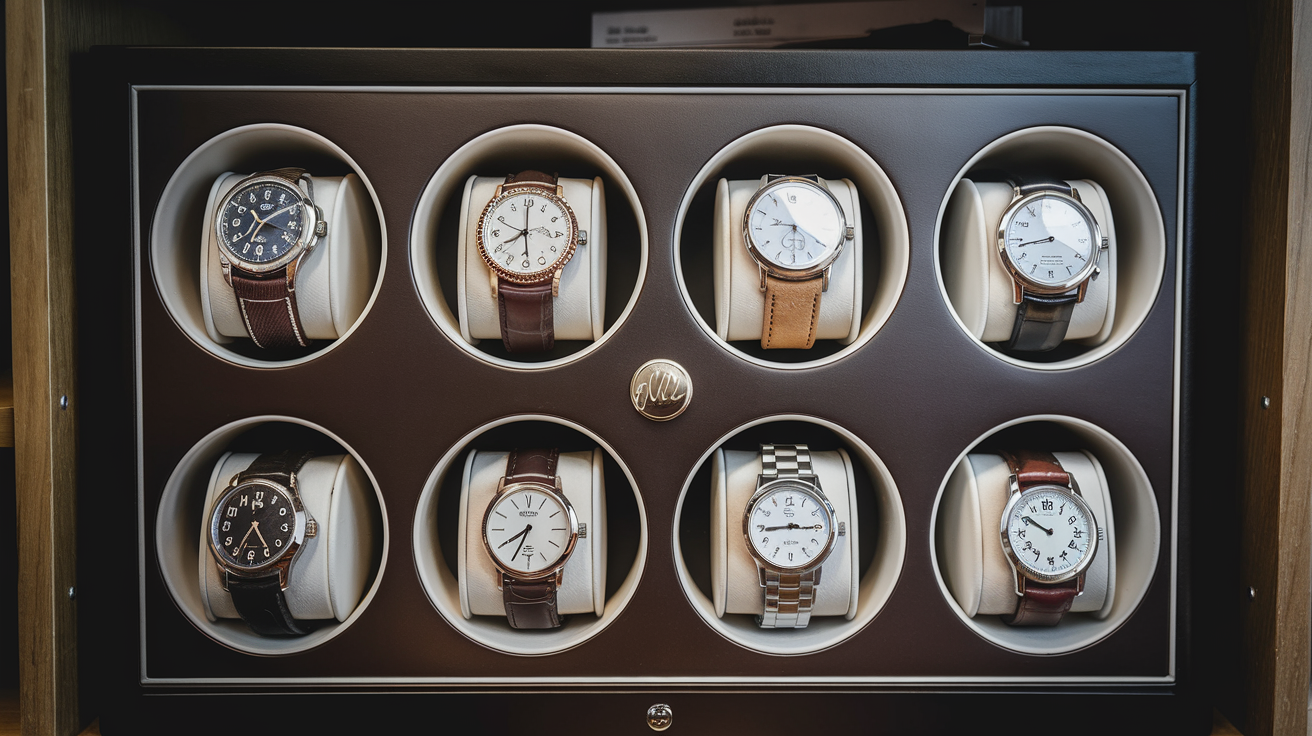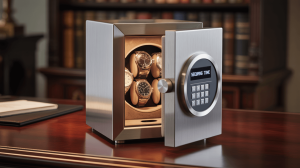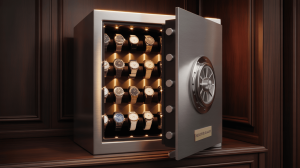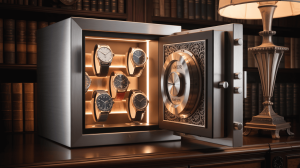The Watch Winder Debate Luxury or Necessity?
In the world of horology, where precision meets artistry, the debate over watch winders rages on. Is this sleek, rotating device an indispensable tool for the modern watch enthusiast, or merely an extravagant indulgence? For owners of automatic timepieces, the question isn’t just about convenience—it’s about preserving the heartbeat of their prized possessions. A watch winder, with its gentle, rhythmic motion, mimics the natural movement of the wrist, ensuring your watch remains wound and ready to wear. But does it truly enhance longevity, or is it a cleverly marketed luxury?
The allure of a watch winder lies in its promise of effortless maintenance. No more resetting the time, date, or moon phase complications after days of neglect. Yet, critics argue that these devices are unnecessary, even potentially harmful, with claims of overwinding and excessive wear. So, where does the truth lie? Is a watch winder a worthy investment for your Rolex, TAG Heuer, or Patek Philippe, or just another gadget cluttering your dresser? Dive into this exploration of functionality, craftsmanship, and value to uncover whether a watch winder deserves a place in your collection—or your budget
Chapter 1: Understanding Automatic Watches
How Automatic Watches Work
At the core of every self-winding timepiece lies a fascinating interplay of mechanics and motion. Unlike their manual counterparts, these devices harness the kinetic energy generated by the wearer’s daily activities. A semicircular rotor, often referred to as an oscillating weight, spins freely with each gesture of the wrist. This motion transfers energy to the mainspring, a tightly coiled component that stores power. As the mainspring unwinds, it drives a series of gears, known as the gear train, which regulate the movement of the hands. The escapement mechanism ensures the energy is released in controlled bursts, maintaining precision. This intricate dance of components allows the device to function seamlessly without the need for manual intervention.
The Role of Movement in Keeping Your Watch Alive
The vitality of a self-winding timepiece is directly tied to the wearer’s activity. Without regular motion, the mainspring loses its tension, causing the device to stop. This is where the concept of a power reserve comes into play. Most models can operate for 40 to 50 hours without additional input, though some high-end versions boast reserves lasting several weeks. For those who rotate their collection or don’t wear their piece daily, a watch winder can simulate the necessary motion to keep the mechanism active. This not only ensures the timepiece remains ready to wear but also helps maintain the lubrication of internal components, preventing wear and tear.
By understanding these principles, you can appreciate the ingenuity behind these mechanical marvels and make informed decisions about their care and maintenance.
Chapter 2: What Does a Watch Winder Do?
Simulating Wrist Movement: The Science Behind It
At its core, a watch winder replicates the natural motion of the human arm to keep self-winding timepieces operational. When worn, the oscillating weight inside the device rotates with each gesture, transferring energy to the mainspring. This process ensures the mechanism remains active and accurate. A winder mimics this by gently rotating the timepiece at intervals, maintaining tension in the mainspring and preventing it from unwinding. The key lies in the precision of the motor, which must replicate the subtle, rhythmic movements of daily wear without overexerting the internal components.
The Mechanics of Watch Winders
These devices are engineered with a motorized base that rotates the timepiece in a circular motion. The direction and speed of rotation can often be adjusted to match the specific requirements of different models. For instance, some mechanisms require clockwise motion, while others benefit from bidirectional rotation. The turns per day (TPD) setting ensures the device doesn’t overwind the mainspring, which could lead to unnecessary wear. High-quality winders also feature silent motors and secure cushions to protect the timepiece from damage or excessive movement.
By understanding these principles, you can appreciate how a winder not only keeps your device ready to wear but also preserves its internal mechanisms for long-term use.
Chapter 3: The Benefits of Owning a Watch Winder
Convenience: Always Ready to Wear
Imagine reaching for your favorite timepiece and finding it perfectly wound, with the correct time and date displayed. A watch winder eliminates the hassle of manual adjustments, ensuring your device is always ready for use. This is especially valuable for those who rotate between multiple pieces in their collection. No more resetting complications like moon phases or perpetual calendars—just grab and go.
Longevity: Keeping Your Watch in Top Shape
Regular movement is crucial for maintaining the internal mechanics of your device. A winder ensures the mainspring remains tensioned, preventing lubricants from settling or drying out. This reduces wear on delicate components, extending the lifespan of your timepiece. For high-end models with intricate mechanisms, this consistent motion is essential to preserving their precision and functionality.
Protection: Shielding Your Timepiece from Dust and Magnetism
When not in use, your device is vulnerable to environmental factors like dust and magnetic fields, which can disrupt its accuracy. A winder often comes with a protective case, safeguarding your piece from these hazards. Additionally, the gentle rotation keeps internal parts active, minimizing the risk of corrosion or damage from prolonged inactivity.
By investing in a winder, you not only enhance the convenience of owning a self-winding device but also ensure its longevity and protection for years to come.

Chapter 4: The Drawbacks of Watch Winders
Over-Winding: Is It a Real Concern?
One of the most debated issues surrounding these devices is the risk of overwinding. Modern self-winding mechanisms are designed with slip clutches to prevent excessive tension in the mainspring. However, low-quality winders with improper settings or faulty motors can still pose a threat. Overuse or incorrect rotation patterns may strain the internal components, leading to premature wear. It’s essential to choose a device with adjustable settings to match your timepiece’s specific needs.
Cost: Are Watch Winders Worth the Investment?
High-quality models can be a significant expense, often ranging from hundreds to thousands of dollars. For collectors with multiple pieces, the cost can quickly add up. While these devices offer convenience and protection, not every owner may find the price justified. For those with a single, frequently worn timepiece, manual winding or regular wear might be a more practical solution.
Space and Aesthetics: Does It Fit Your Lifestyle?
These devices, especially multi-watch versions, can take up considerable space on a dresser or shelf. Their design, while often sleek, may not align with everyone’s decor preferences. Additionally, the constant rotation, even if silent, might be a distraction in quiet environments. For minimalists or those with limited space, the practicality of owning a winder may be outweighed by its footprint.
While these devices offer undeniable benefits, it’s important to weigh their potential drawbacks to determine if they align with your needs and lifestyle.
Chapter 5: Who Really Needs a Watch Winder?
The Watch Collector: Managing Multiple Timepieces
For enthusiasts with an extensive collection, a winder is more than a convenience—it’s a necessity. Rotating between numerous devices ensures each one remains active and ready for wear. Without a winder, manually resetting complications like perpetual calendars or moon phases can become a tedious chore. Additionally, keeping mechanisms in motion helps maintain the lubrication of internal parts, reducing the risk of wear and tear. For those with a passion for horology, this tool is an essential part of their arsenal.
The Occasional Wearer: Is It Overkill?
If you only wear your device sporadically, a winder might seem excessive. However, for pieces with intricate mechanisms or long power reserves, it can prevent the hassle of frequent adjustments. For simpler models, manual winding or occasional wear may suffice. The decision ultimately depends on the complexity of your timepiece and your tolerance for resetting it.
The Luxury Watch Owner: Preserving Value and Precision
High-end devices often feature delicate mechanisms that benefit from consistent motion. A winder ensures these pieces remain accurate and functional, preserving their value over time. For collectors of prestigious brands, this investment not only enhances convenience but also safeguards the craftsmanship and precision of their prized possessions.
By understanding your needs and the specifics of your collection, you can determine whether a winder is a worthwhile addition to your horological toolkit.
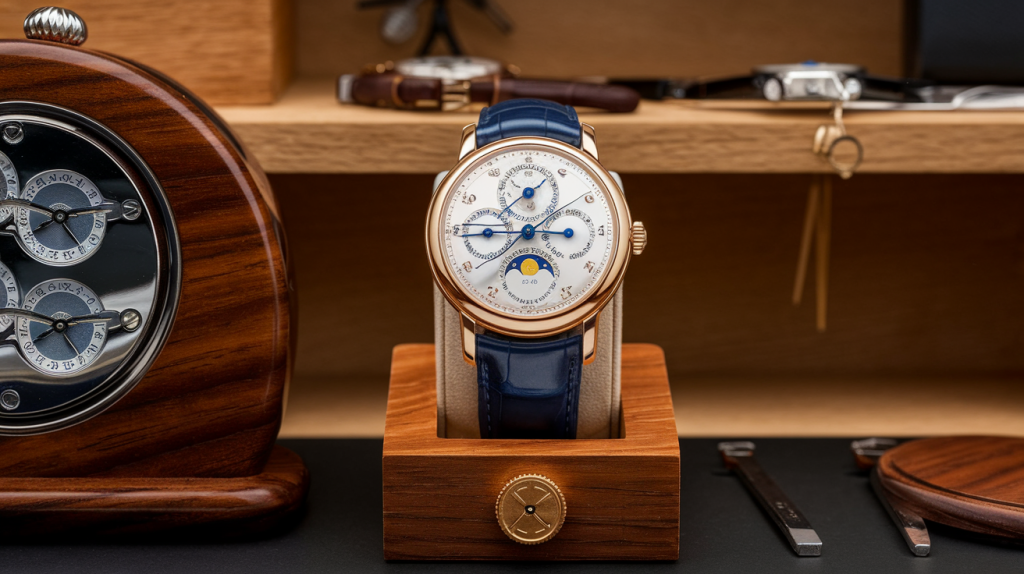
Chapter 6: Watch Winder Myths vs. Facts
Myth: Watch Winders Extend the Life of All Watches
A common misconception is that these devices universally prolong the lifespan of every timepiece. While they can help maintain mechanisms by keeping lubricants evenly distributed, not all models require constant motion. Simple designs with minimal complications may not benefit significantly, and excessive use could even lead to unnecessary wear. It’s essential to understand the specific needs of your device before investing in a winder.
Fact: Not All Watches Benefit from a Winder
Devices with basic functions or those worn regularly may not need a winder. Manual winding or occasional wear can suffice for these pieces. However, for intricate mechanisms like perpetual calendars or moon phases, a winder ensures accuracy and reduces the hassle of frequent adjustments. The key is to assess whether your timepiece truly requires this tool.
Myth: Watch Winders Are Just for Show
Some believe these devices are purely decorative, but they serve a practical purpose. By simulating wrist movement, they keep mechanisms active and prevent lubricants from settling. For collectors with multiple pieces, winders save time and effort, ensuring each device is ready to wear. While many models feature elegant designs, their functionality is far from superficial.
By debunking these myths, you can make informed decisions about whether a winder is a worthwhile addition to your horological toolkit.
Chapter 7: Features to Look for in a Watch Winder
Rotation Settings: Clockwise, Counterclockwise, or Bidirectional?
Different mechanisms require specific winding directions to function optimally. Some devices need clockwise motion, while others benefit from counterclockwise or bidirectional rotation. Adjustable settings allow you to customize the turns per day (TPD) to match your timepiece’s requirements. This ensures the mainspring remains tensioned without overexerting the internal components.
Noise Levels: Silent Operation for Peace of Mind
A high-quality motor ensures quiet performance, making the device suitable for bedrooms or offices. Excessive noise can be distracting and may indicate poor craftsmanship. Look for models with advanced motor technology that operate smoothly and silently, providing a seamless experience.
Design and Materials: Matching Your Style and Needs
The exterior of the device should complement your decor while offering durability. Options range from sleek carbon fiber to elegant wood finishes. Premium materials not only enhance aesthetics but also ensure longevity. Additionally, secure cushions and protective cases safeguard your timepiece from dust and damage.
By prioritizing these features, you can select a device that meets both functional and aesthetic needs, ensuring your timepiece remains in pristine condition.
Chapter 8: Top Watch Winder Brands and Models
Orbita: The Gold Standard
Renowned for its precision and innovation, Orbita has set the benchmark in the industry. Their patented Rotorwind technology mimics natural wrist movement, ensuring optimal performance for your timepiece. Models like the Orbita Piccolo and Avanti 3 combine durability with elegant design, making them a favorite among collectors. With features like silent operation and long-lasting battery life, Orbita remains a top choice for discerning enthusiasts.
Wolf Designs: Luxury Meets Functionality
Wolf Designs blends sophistication with practicality, offering devices that cater to high-end collections. Their Viceroy and Heritage series provide customizable rotation settings and sleek aesthetics, often crafted from premium materials like wood and carbon fiber. Known for their quiet motors and reliable performance, Wolf’s creations are ideal for those seeking both style and substance.
Eilux: Affordable Elegance
For those seeking quality without breaking the bank, Eilux delivers exceptional value. Their devices, crafted with attention to detail, offer reliable winding capabilities at a fraction of the cost. With options ranging from single to multi-watch models, Eilux ensures that even budget-conscious collectors can maintain their timepieces in pristine condition.
These brands represent the pinnacle of craftsmanship and innovation, catering to a wide range of needs and preferences in the world of horology.
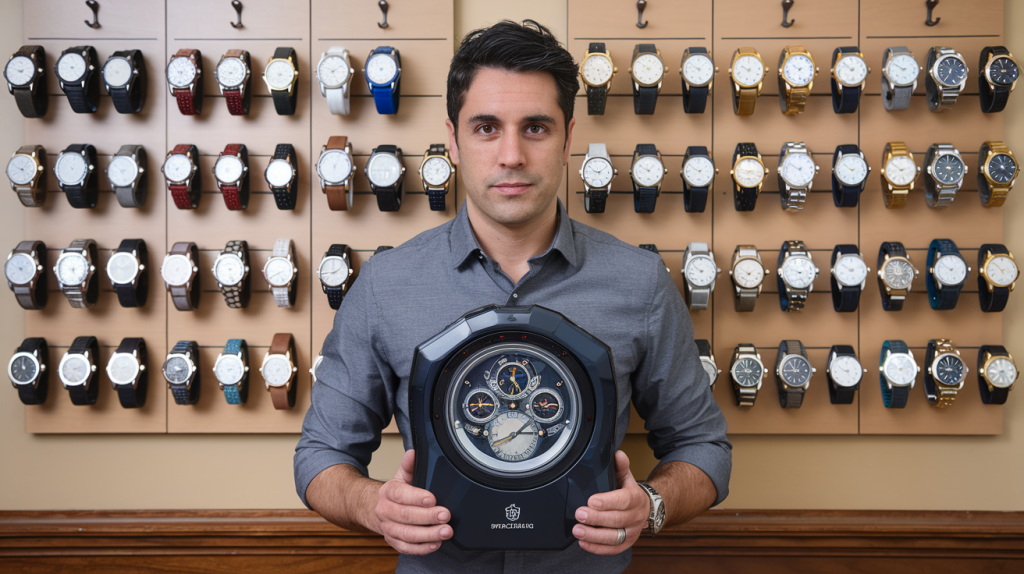
Chapter 9: Alternatives to Watch Winders
Manual Winding: The Old-School Approach
For those who prefer a hands-on method, manually winding your timepiece is a reliable and traditional option. This approach allows you to connect with your device on a personal level, ensuring it’s ready for use whenever needed. It’s particularly suitable for simpler mechanisms that don’t require frequent adjustments. Just remember to follow the manufacturer’s guidelines to avoid over-tensioning the mainspring.
Regular Wear: The Natural Solution
Wearing your device daily is the simplest way to keep it active. The natural motion of your wrist provides the necessary energy to maintain its function. This method is ideal for those who use their timepiece consistently and don’t want to invest in additional tools. However, for pieces with long power reserves or intricate complications, this might not suffice.
Storage Solutions: Keeping Your Watch Safe Without a Winder
Proper storage is crucial for preserving your device’s condition. A dedicated box with padded compartments protects against dust, scratches, and environmental changes. For added security, consider a climate-controlled space or a lockable case. These options ensure your timepiece remains safe and ready for use, even without a winder.
By exploring these alternatives, you can find a method that aligns with your lifestyle and keeps your timepiece in optimal condition.
Chapter 10: The Cost of Watch Winders – Breaking It Down
Entry-Level Options: Are They Worth It?
Budget-friendly devices can be a practical choice for those new to the world of automatic timepieces. While they may lack advanced features like customizable rotation or premium materials, they still provide basic functionality to keep your device active. Brands like Eilux offer reliable models that cater to casual users or those with simpler mechanisms. However, it’s important to ensure the motor is quiet and durable, as cheaper options may compromise on quality.
High-End Models: Justifying the Price Tag
Premium devices from brands like Orbita and Wolf Designs come with a higher cost, but they offer unmatched craftsmanship and advanced features. Customizable settings, silent motors, and luxurious materials like carbon fiber or fine wood make these models a worthwhile investment for serious collectors. They not only enhance the functionality of your device but also serve as elegant display pieces, complementing your decor.
Long-Term Savings: Protecting Your Investment
While the initial expense may seem steep, a high-quality device can save you money over time. By keeping your mechanism active, it prevents lubricants from drying out and reduces the need for costly repairs. For owners of luxury timepieces, this ensures the value and precision of your collection are preserved, making it a smart financial decision in the long run.
By understanding the cost breakdown, you can choose a device that aligns with your needs and budget, ensuring your timepiece remains in optimal condition.

Chapter 11: Watch Winders and Watch Maintenance
How Watch Winders Complement Servicing
Devices that keep your timepiece active play a crucial role in preserving its functionality. By simulating wrist movement, they ensure the internal mechanisms remain operational, reducing the need for frequent adjustments. This is particularly beneficial for intricate complications like perpetual calendars or moon phases, which can be complex to reset. Regular use of such tools can also help identify potential issues early, making servicing more efficient and less costly.
The Role of Lubrication in Watch Longevity
Proper lubrication is essential for the smooth operation of a timepiece’s moving parts. When a device is left inactive for extended periods, oils can settle or dry out, leading to increased friction and wear. By keeping the mechanism in motion, these tools help distribute lubricants evenly, maintaining optimal performance and extending the lifespan of your device. This is especially important for high-end models with delicate components.
Avoiding Common Maintenance Mistakes
One frequent error is overwinding, which can strain the mainspring and damage internal parts. Another is neglecting to clean the device regularly, allowing dust and debris to accumulate. Additionally, using incorrect rotation settings or failing to secure the timepiece properly can lead to unnecessary wear. By following manufacturer guidelines and investing in quality tools, you can prevent these issues and ensure your device remains in pristine condition.
By understanding these aspects, you can effectively integrate these tools into your maintenance routine, ensuring your timepiece stays accurate and reliable for years to come.
Chapter 12: Real-Life Experiences with Watch Winders
Testimonials from Watch Enthusiasts
Many collectors praise these devices for their ability to keep timepieces ready for use at any moment. One user shared how their automatic watch remained accurate for months without manual intervention, thanks to a reliable device. Another enthusiast highlighted the convenience of having multiple slots in their unit, allowing them to maintain an entire collection effortlessly. These firsthand accounts underscore the practicality and value of these tools in daily life.
Expert Opinions: What Watchmakers Say
Horologists emphasize the importance of using these tools correctly to preserve the integrity of a timepiece. Experts recommend selecting a device with customizable settings to match the specific needs of each watch. They also advise against overuse, as excessive rotation can lead to unnecessary wear. By following these guidelines, owners can ensure their devices remain in optimal condition for years to come.
Common Complaints and How to Avoid Them
Some users report issues like excessive noise or inconsistent rotation, often due to low-quality motors. To avoid these problems, invest in a device with a silent motor and reliable performance. Another frequent concern is over-tensioning the mainspring, which can be prevented by setting the correct turns per day (TPD). Regular maintenance, such as cleaning the unit and checking its functionality, also helps address potential issues before they escalate.
By learning from real-life experiences and expert advice, you can make informed decisions and maximize the benefits of these tools for your collection.
Chapter 13: Watch Winders as a Gift Idea
Why Watch Winders Make Great Gifts
These devices are a thoughtful and practical present for anyone who owns an automatic timepiece. They ensure the mechanism remains active, preserving its accuracy and longevity. For collectors or enthusiasts, it’s a luxury accessory that enhances their collection while offering convenience. It’s a gift that combines functionality with elegance, making it perfect for special occasions like birthdays, anniversaries, or holidays.
Choosing the Right Winder for a Loved One
When selecting a device, consider the recipient’s collection size and preferences. For a single timepiece, a compact model with customizable settings is ideal. For those with multiple devices, a multi-slot unit with silent motors and premium materials like wood or carbon fiber is a great choice. Brands like Orbita and Wolf Designs offer options that cater to both functionality and aesthetics.
Presentation and Packaging: Adding a Personal Touch
The way you present the gift can elevate the experience. Opt for elegant packaging that reflects the recipient’s style, such as a sleek box with a personalized message or monogram. Adding a handwritten note explaining the device’s benefits can make the gesture even more meaningful. For an extra touch, consider pairing it with a travel case or a cleaning kit to complete the gift.
By focusing on these aspects, you can give a gift that is both thoughtful and practical, ensuring it’s cherished for years to come.

Chapter 14: The Environmental Impact of Watch Winders
Energy Consumption: Are They Eco-Friendly?
These devices, especially those with AC adapters, consume electricity to keep mechanisms active. While the energy usage is relatively low, it’s still worth considering for eco-conscious individuals. Opting for models with energy-efficient motors or battery-powered options can reduce the environmental footprint. Additionally, unplugging the device when not in use can further minimize energy waste.
Sustainable Materials: Brands Leading the Way
Some manufacturers are prioritizing eco-friendly practices by using sustainable materials in their products. For instance, brands like Wolf Designs incorporate responsibly sourced wood and recyclable components into their designs. Others are exploring alternatives like bamboo or biodegradable plastics to create devices that are both functional and environmentally conscious. Supporting these brands can help promote sustainability in the industry.
Longevity vs. Waste: A Thoughtful Perspective
A well-made device can last for years, reducing the need for frequent replacements and minimizing waste. Investing in a durable, high-quality model ensures it remains functional for a long time, making it a more sustainable choice. By focusing on longevity and proper maintenance, users can contribute to reducing the environmental impact of these tools while preserving their timepieces.
By considering these factors, you can make informed decisions that align with both your horological needs and environmental values.
Chapter 15: The Future of Watch Winders
Technological Advancements: What’s Next?
The next generation of these devices is poised to embrace cutting-edge innovations. Expect advancements like AI-driven rotation algorithms that adapt to the specific needs of each timepiece, ensuring optimal performance. Additionally, eco-friendly materials and energy-efficient motors are likely to dominate, aligning with global sustainability trends. These developments will not only enhance functionality but also reduce environmental impact, making them a smarter choice for conscious consumers.
Smart Watch Winders: Integration with Modern Devices
Integration with smart technology is set to revolutionize these tools. Imagine a device that syncs with your smartphone, allowing you to monitor and control its settings remotely. Features like real-time diagnostics, maintenance reminders, and even integration with smart home systems could become standard. This seamless connectivity will offer unparalleled convenience, ensuring your timepiece is always in perfect condition without manual intervention.
The Evolution of Watch Care
The future of maintaining timepieces will focus on holistic care. Beyond keeping mechanisms active, these tools may incorporate features like humidity control and anti-dust systems to protect against environmental factors. Advanced models could even include diagnostic capabilities, alerting you to potential issues before they escalate. This evolution will transform these devices from simple accessories to essential guardians of horological longevity.
By embracing these advancements, the industry is set to redefine how we preserve and care for our cherished timepieces, ensuring they remain timeless for generations to come.
16. Conclusion: Is a Watch Winder Worth It for You?
Weighing the Pros and Cons
Owning a device to keep your timepiece active has its advantages and drawbacks. On the positive side, it ensures your device remains accurate and ready to wear, especially for models with complex complications. It also helps distribute lubricants evenly, potentially extending the lifespan of the mechanism. However, it’s not essential for all owners, and some argue it’s more of a luxury than a necessity. Additionally, energy consumption and cost can be concerns for eco-conscious individuals or those on a budget.
Making an Informed Decision
Before investing, consider your lifestyle and collection. If you own multiple automatic timepieces or frequently rotate between them, this tool can save time and effort by eliminating the need for manual adjustments. For those with simpler devices or who wear their timepiece daily, it may not be as beneficial. Research brands like Orbita and Wolf Designs, known for their quality and customizable settings, to find a model that suits your needs.
Final Thoughts: Luxury, Convenience, or Both?
Ultimately, the value of this accessory depends on your priorities. For collectors, it’s a blend of practicality and elegance, enhancing the care and presentation of their devices. For others, it’s a luxury item that adds convenience but isn’t essential. Whether you view it as a necessity or a thoughtful indulgence, choosing a high-quality model ensures it complements your timepiece and lifestyle seamlessly.
By carefully evaluating your needs and preferences, you can determine if this investment aligns with your horological goals.
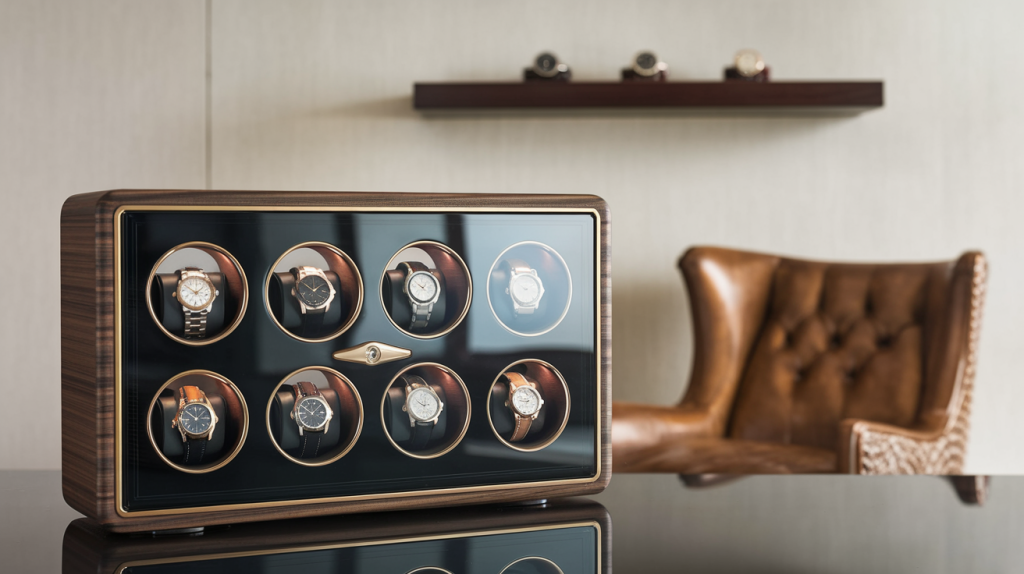
17.FAQs About Watch Winders
Do Watch Winders Damage Watches?
High-quality devices are generally safe for your timepiece, as they mimic natural wrist movement to keep the mechanism active. However, poorly made models or incorrect settings can cause issues like over-tensioning or excessive wear. To avoid damage, choose a reliable brand with adjustable rotation settings and a silent motor.
How Often Should I Use a Watch Winder?
The frequency depends on how often you wear your timepiece. If you rotate between multiple devices, using it daily ensures they remain accurate and ready to wear. For those who wear their watch regularly, occasional use during periods of inactivity is sufficient.
Can I Use One Winder for Multiple Watches?
Yes, multi-slot units are designed to accommodate several devices simultaneously. Ensure the model offers customizable settings for each slot to match the specific needs of your collection. This is especially useful for collectors with diverse timepieces.
Are Watch Winders Noisy?
Premium models are engineered to operate quietly, making them suitable for bedrooms or offices. Look for devices with silent motors to avoid disruptions. Cheaper options may produce noticeable noise, so investing in quality is key.
What’s the Best Watch Winder for Beginners?
For those new to these devices, a compact, single-slot model with adjustable settings is ideal. Brands like Orbita and Wolf Designs offer user-friendly options that balance functionality and affordability. These are perfect for starting your journey into maintaining automatic timepieces.
By addressing these common questions, you can make informed decisions and ensure your devices remain in optimal condition.

